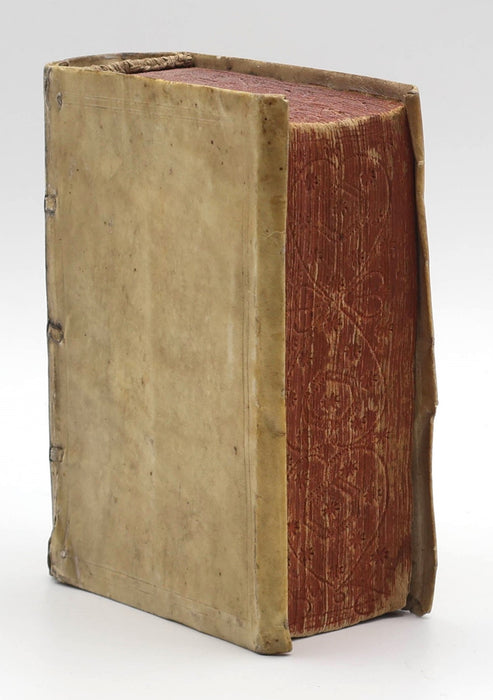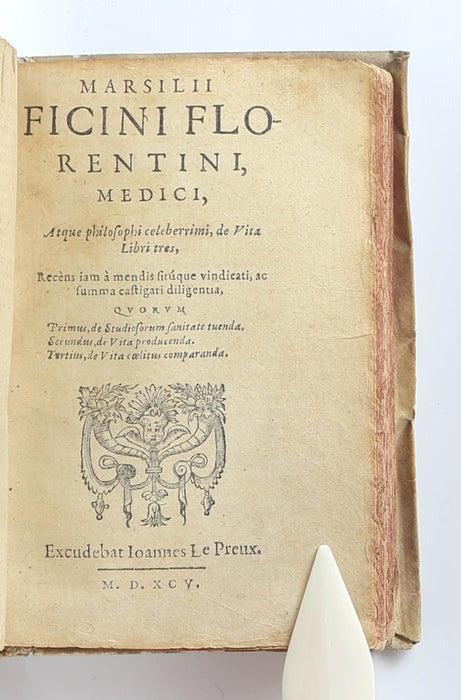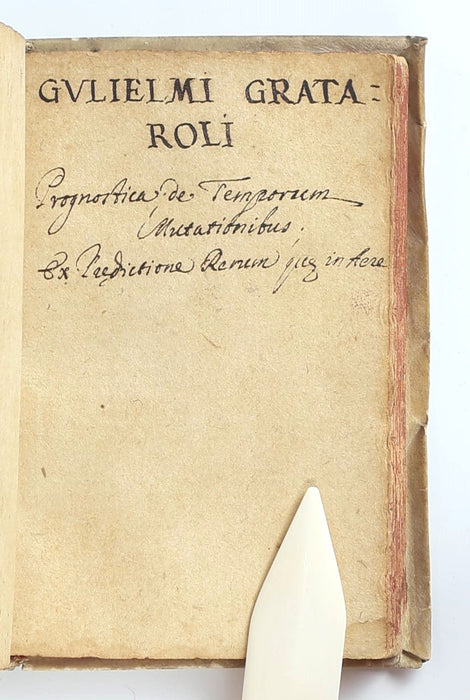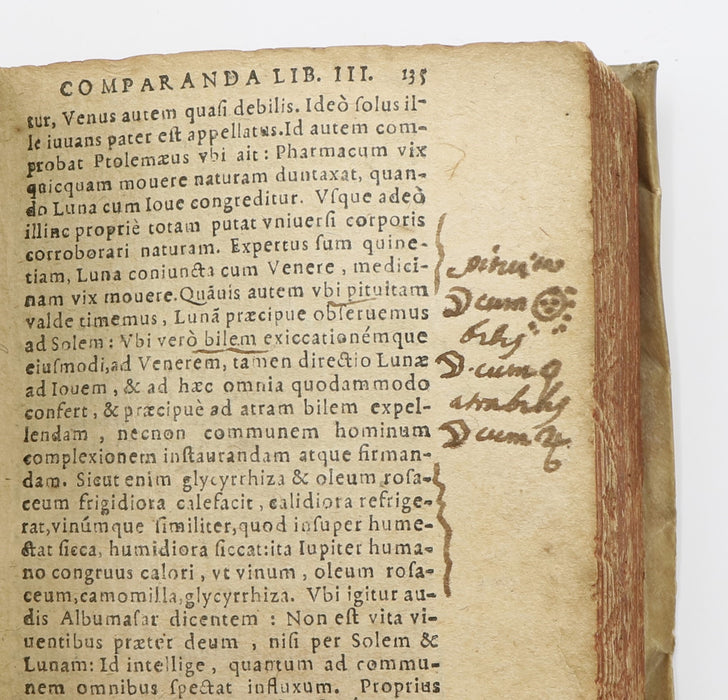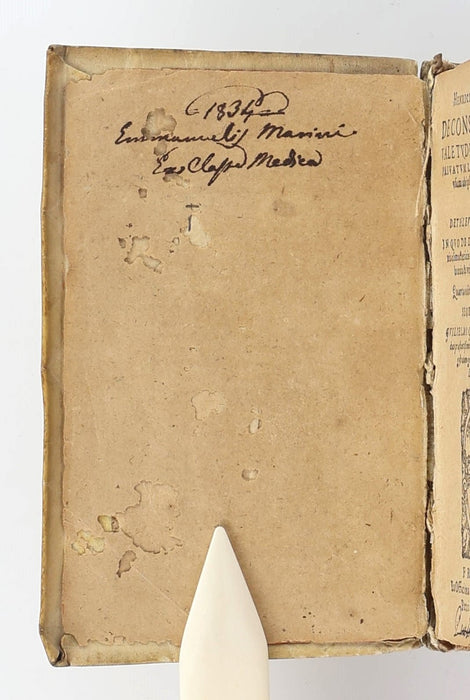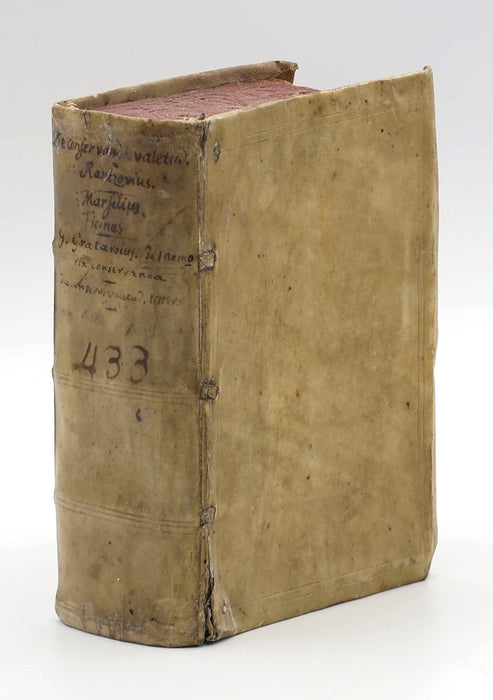
16TH-CENTURY MEDICAL COMPILATION - HEALTH OF THE LEARNED
Rantzau, Heinrich [Gratarolo, Guglielmo]: De conservanda valetudine liber, in privatum liberorum suorum usum ab ipso conscriptus, ac editus a Dethlevo Silvio Holsato … quarta editio … seorsim accessit de literatorum, & eorum qui magistratum gerunt, conservanda valetudine, liber. Francofurti: Ex Officina Paltheniana, 1596. [Bound with]: Ficino, Marsilio: De vita libri tres, recèns iam à mendis sitúque vindicati, ac summa castigati diligentia. [Geneva]: Excudebat Ioannes Le Preux, 1595.
A sixteenth-century sammelband of medical literature with a recurring theme of the health of the learned. It comprises—in two publications— texts by Heinrich Rantzau (1526–1598), Guglielmo Grataroli (1516–1568), and Marsilio Ficino (1433–1499). These works are bound with blanks for notes, and indeed this volume has several intriguing annotations. The compilation survives in an early vellum binding and has striking red gauffered edges.
The first three texts here are part of the same publication. The pagination and signatures run continuously across the three texts, and the same imprint details appear on the three title pages.
This tripartite publication starts with Rantzau’s ‘De conservanda valetudine’ (‘On the Conservation of Health’), which was originally printed in 1576. Rantzau was governor of Schleswig-Holstein, but he also took a keen interest in writing, publishing, and collecting books (Zeeberg 2021).
The second and third texts are both by Grataroli, a Calvinist physician who was exiled from Italy. ‘De literatorum’, was originally printed in 1555 and concerns the health of learned men. ‘De Memoria Reparanda’ was first printed in 1553 and relates to memory.
The final text in the book, which comprises the second publication, is ‘De vita libri tres’ (‘Three Books on Life’). This text was written by Marsilio Ficino, a Florentine philosopher whose family had close ties to the Medici (Allen 2002, p. xiii). ‘Three Books on Life’, first printed in 1489, is an astro-medical work ‘with the stated aim […] of teaching intellectuals how to stay healthy.’ (Kraye 2002, p. 377).
124 blank pages follow Ficino’s ‘De vita libri tres’ (including the two final blanks at the end of the edition). Presumably the text was bound this way to allow space for notes, or for other relevant work(s) to be added by hand. Indeed, it would appear that an early reader has used the second blank to create a handwritten title page for another text by Grataroli, in imitation of printed title pages. However, no further text has been added.
In addition to this handwritten title page, there are many other early inscriptions and annotations that provide evidence of former owners and readers. Most of the annotations are concentrated in pp. 127–44 of the second publication (Ficino’s ‘De vita libri tres’). This portion of the text primarily relates to the impact of the sun, the moon, and Jupiter on the body.
The annotations in this section are the work of one hand, which does not appear to match any of the hands responsible for the various ownership inscriptions (cf. provenance above). This annotating hand is responsible for underlining words and short phrases, adding vertical lines in the margin to highlight sections of text, and writing marginal comments to extract key words and facts. Notably, much of this marginalia incorporates astronomical symbols. On p. 135, for example, Ficino observes that the interaction between the sun and the moon affects phlegm. In the margin, a note has been added to signpost the section.
Preliminary research suggests that the two publications in this medical compilation are not usually found bound together. The red gauffered edges make the compilation visually cohesive from the exterior. The book is also notable for its early vellum binding with fore-edge cover extensions.
Details
Printed. 2 publications in 1 volume, 12.7 x 8.8 cms in binding, duodecimo, pp. 239, [1]; 334, [18], [120]. Bound with 60 blank leaves at end. Publication 1 collation: 2A–2P8; publication 2 collation: A–Y8 (Y7 and Y8 blank). Publication 1 has three title pages (with same imprint statement); the signatures and pagination run continuously. Publications 1 and 2 both have decorative initials and woodcut ornaments at section divisions.
Condition: Repair to first title page of publication 1, with small part of woodcut decoration neatly substituted by hand. Worming to front free endpaper. Browning to pages, slight water damage in bottom margin of some pages. Occasional small tears to blank edges, some minor stains.
Bound in vellum with fore edge cover extensions. Blind-tooled double fillet on both covers. Four spine compartments. Lettering to spine (De conservanda valetud. / Rantzovius. / Marsilius. / Ficinus / G. Gratarolus. De <m>emo / ria conservanda / De conservi valetud. litter. / 433). Red edges, gauffered. One free endpaper at front and one at rear. Vellum slightly stained, boards detaching slightly from spine, fading to red edges, worming and slight tears to pastedowns.
Provenance:
- Text added by hand to resemble a printed title page on second blank following publication 2 (GVLIELMI GRATIA-ROLI Prognostica de Temporum Mutationibus Ex Predictione Rerum qu[orum] in [?]ere).
- Cancelled ownership inscription on first title page of publication 1 (Pauli Manf[??]d).
- Ownership inscription on second title page of publication 1 (Ioannis Schevi). The same ownership inscription appears on the first title page of publication 1 but the surname is cancelled.
- Possible library shelfmark on spine (433).
- Frequent marginal annotations, especially in publication 2, pp. 127–44.
- Ownership inscription on verso of front free endpaper, very slightly obscured by worming (1834 E<mm>anuelij Marini Ex classe Medica)
anuelij Marini Ex classe Medica). - Ink note on rear pastedown (14 ce[??]yf)
- Various pencil notes on front and rear pastedowns, some of which could be shelfmarks (e.g. ‘F 102’).
Bibliography
Publication 1: USTC 662045. VD16 R228 (with additional numbers VD16 G 2891 and VD16 G 2896).
Publication 2: USTC 451492; GLN 15–16 3797. OCLC and USTC shows copies of publication 2 outside mainland Europe at Edinburgh University Library, Queen’s College Library Oxford, Newberry Library, Harvard University Divinity School Library, National Library of Medicine.
Allen, Michael J. B., ‘Introduction’, in Michael J. B. Allen, Valery Rees, and Martin Davies (eds.), Marsilio Ficino: His Theology, His Philosophy, His Legacy (Leiden: Brill, 2002), pp. xiii–xxii.
Celati, Alessandra, ‘Heretical Physicians in sixteenth-century Italy: The Fortunes of Girolamo Massari, Guglielmo Grataroli, and Teofilo Panarelli’, Society and Politics 12, no. 1 (2018): 11–31.
Kraye, Jill, ‘Ficino in the Firing Line: A Renaissance Neoplatonist and his Critics’, in Michael J. B. Allen, Valery Rees, and Martin Davies (eds.), Marsilio Ficino: His Theology, His Philosophy, His Legacy (Leiden: Brill, 2002), pp. 377–97.
Pastore, Allesandro, ‘Grataroli, Guglielmo’, Dizionario Biografico degli Italiani 58 (2002). Last accessed on 6 August 2021.
Zeeberg, Peter, ‘Heinrich Rantzau (1526– 1598): Patron of the Arts and Bibliophile’, Renæssance forum 15 (2009): 15–32. Last accessed 6 August 2021.

